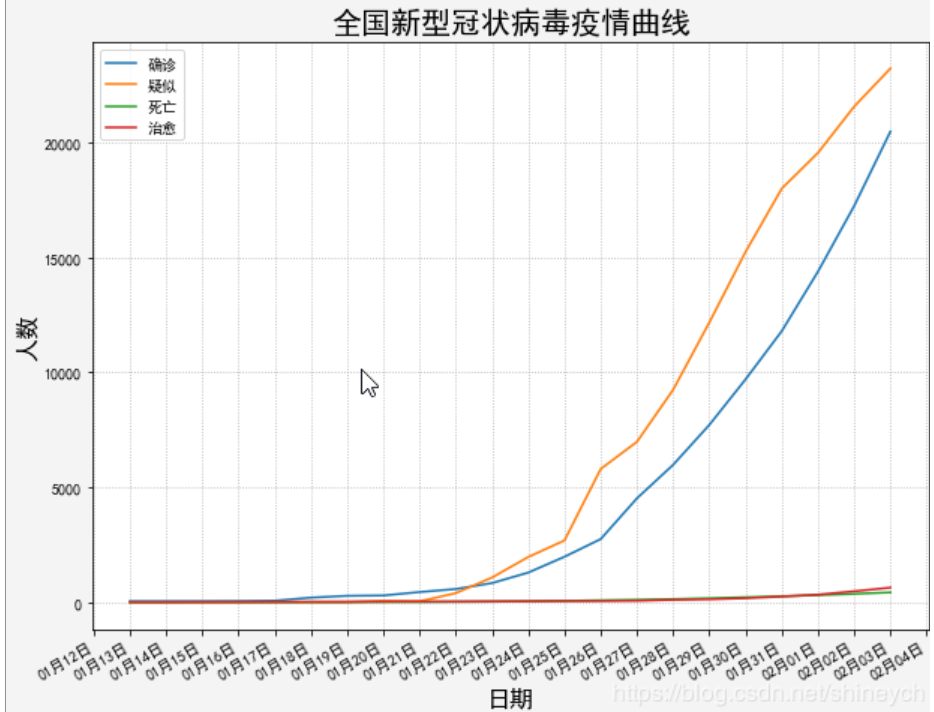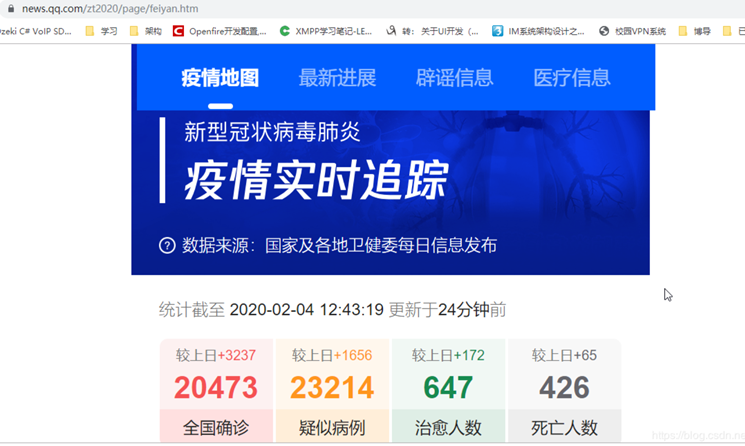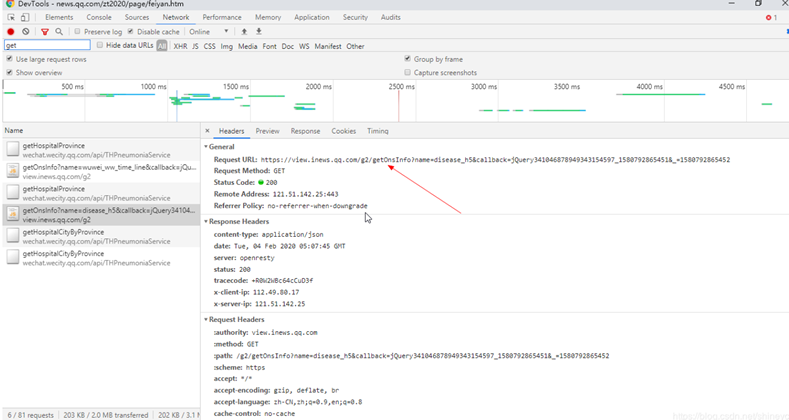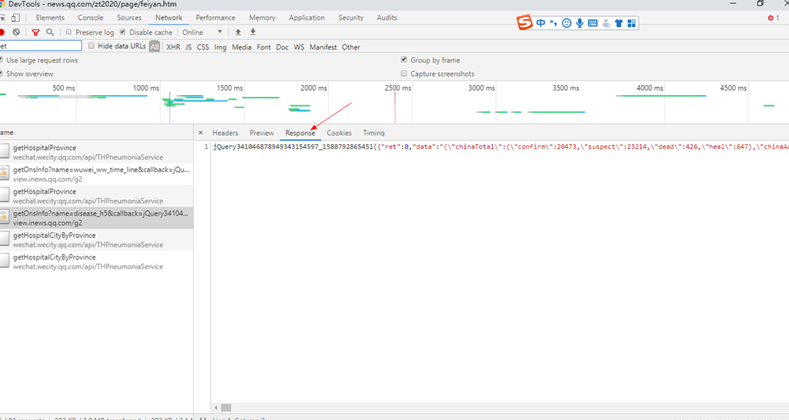жӮЁеҘҪпјҢзҷ»еҪ•еҗҺжүҚиғҪдёӢи®ўеҚ•е“ҰпјҒ
жӮЁеҘҪпјҢзҷ»еҪ•еҗҺжүҚиғҪдёӢи®ўеҚ•е“ҰпјҒ
иҝҷзҜҮж–Үз« дё»иҰҒд»Ӣз»ҚPythonжҠ“ж–°еһӢеҶ зҠ¶з—…жҜ’иӮәзӮҺз–«жғ…ж•°жҚ®е№¶з»ҳеҲ¶е…ЁеӣҪз–«жғ…еҲҶеёғзҡ„жЎҲдҫӢеҲҶжһҗпјҢж–Үдёӯд»Ӣз»Қзҡ„йқһеёёиҜҰз»ҶпјҢе…·жңүдёҖе®ҡзҡ„еҸӮиҖғд»·еҖјпјҢж„ҹе…ҙи¶Јзҡ„е°Ҹдјҷдјҙ们дёҖе®ҡиҰҒзңӢе®ҢпјҒ
иҝҗиЎҢз»“жһңпјҲ2020-2-4ж—Ҙж•°жҚ®пјү


ж•°жҚ®жқҘжәҗ
news.qq.com/zt2020/page/feiyan.htm

жҠ“еҢ…еҲҶжһҗ


ж—ҘжҠҘж•°жҚ®ж јејҸ
"chinaDayList": [{
"date": "01.13",
"confirm": "41",
"suspect": "0",
"dead": "1",
"heal": "0"
}, {
"date": "01.14",
"confirm": "41",
"suspect": "0",
"dead": "1",
"heal": "0"
}, {
"date": "01.15",
"confirm": "41",
"suspect": "0",
"dead": "2",
"heal": "5"
}, {
гҖӮгҖӮгҖӮгҖӮгҖӮгҖӮе…ЁеӣҪеҗ„ең°з–«жғ…ж•°жҚ®ж јејҸ
"lastUpdateTime": "2020-02-04 12:43:19",
"areaTree": [{
"name": "дёӯеӣҪ",
"children": [{
"name": "ж№–еҢ—",
"children": [{
"name": "жӯҰжұү",
"total": {
"confirm": 6384,
"suspect": 0,
"dead": 313,
"heal": 303
},
"today": {
"confirm": 1242,
"suspect": 0,
"dead": 48,
"heal": 79
}
}, {
"name": "й»„еҶҲ",
"total": {
"confirm": 1422,
"suspect": 0,
"dead": 19,
"heal": 36
},
"today": {
"confirm": 176,
"suspect": 0,
"dead": 2,
"heal": 9
}
}, {
гҖӮгҖӮгҖӮгҖӮгҖӮгҖӮең°еӣҫж•°жҚ®
github.com/dongli/china-shapefiles
д»Јз Ғе®һзҺ°
#%%
import time, json, requests
from datetime import datetime
import matplotlib
import matplotlib.pyplot as plt
import matplotlib.dates as mdates
from matplotlib.font_manager import FontProperties
from mpl_toolkits.basemap import Basemap
from matplotlib.patches import Polygon
import numpy as np
import jsonpath
plt.rcParams['font.sans-serif'] = ['SimHei'] # з”ЁжқҘжӯЈеёёжҳҫзӨәдёӯж–Үж Үзӯҫ
plt.rcParams['axes.unicode_minus'] = False # з”ЁжқҘжӯЈеёёжҳҫзӨәиҙҹеҸ·
#%%
# е…ЁеӣҪз–«жғ…ең°еҢәеҲҶеёғ(зңҒзә§зЎ®иҜҠз—…дҫӢ)
def catch_cn_disease_dis():
timestamp = '%d'%int(time.time()*1000)
url_area = ('https://view.inews.qq.com/g2/getOnsInfo?name=disease_h6'
'&callback=&_=') + timestamp
world_data = json.loads(requests.get(url=url_area).json()['data'])
china_data = jsonpath.jsonpath(world_data,
expr='$.areaTree[0].children[*]')
list_province = jsonpath.jsonpath(china_data, expr='$[*].name')
list_province_confirm = jsonpath.jsonpath(china_data, expr='$[*].total.confirm')
dic_province_confirm = dict(zip(list_province, list_province_confirm))
return dic_province_confirm
area_data = catch_cn_disease_dis()
print(area_data)
#%%
# жҠ“еҸ–е…ЁеӣҪз–«жғ…жҢүж—ҘжңҹеҲҶеёғ
'''
ж•°жҚ®жәҗпјҡ
"chinaDayList": [{
"date": "01.13",
"confirm": "41",
"suspect": "0",
"dead": "1",
"heal": "0"
}, {
"date": "01.14",
"confirm": "41",
"suspect": "0",
"dead": "1",
"heal": "0"
}
'''
def catch_cn_daily_dis():
timestamp = '%d'%int(time.time()*1000)
url_area = ('https://view.inews.qq.com/g2/getOnsInfo?name=disease_h6'
'&callback=&_=') + timestamp
world_data = json.loads(requests.get(url=url_area).json()['data'])
china_daily_data = jsonpath.jsonpath(world_data,
expr='$.chinaDayList[*]')
# е…¶е®һжІЎеҝ…иҰҒеҚ•зӢ¬з”ЁlistеӯҳеӮЁпјҢjsonеҸҜиҜ»жҖ§е·Із»ҸеҫҲеҘҪдәҶпјӣиҝҷйҮҢиҝҷж ·еҶҷд»…жҳҜдёәдәҶе°‘иҜҘзӮ№иҖҒзүҲжң¬зҡ„д»Јз Ғ
list_dates = list() # ж—Ҙжңҹ
list_confirms = list() # зЎ®иҜҠ
list_suspects = list() # з–‘дјј
list_deads = list() # жӯ»дәЎ
list_heals = list() # жІ»ж„Ҳ
for item in china_daily_data:
month, day = item['date'].split('.')
list_dates.append(datetime.strptime('2020-%s-%s'%(month, day), '%Y-%m-%d'))
list_confirms.append(int(item['confirm']))
list_suspects.append(int(item['suspect']))
list_deads.append(int(item['dead']))
list_heals.append(int(item['heal']))
return list_dates, list_confirms, list_suspects, list_deads, list_heals
list_date, list_confirm, list_suspect, list_dead, list_heal = catch_cn_daily_dis()
print(list_date)
#%%
# з»ҳеҲ¶жҜҸж—ҘзЎ®иҜҠе’Ңжӯ»дәЎж•°жҚ®
def plot_cn_daily():
# list_date, list_confirm, list_suspect, list_dead, list_heal = catch_cn_daily_dis()
plt.figure('novel coronavirus', facecolor='#f4f4f4', figsize=(10, 8))
plt.title('е…ЁеӣҪж–°еһӢеҶ зҠ¶з—…жҜ’з–«жғ…жӣІзәҝ', fontsize=20)
print('ж—Ҙжңҹе…ғзҙ ж•°пјҡ', len(list_date), "\nзЎ®иҜҠе…ғзҙ ж•°пјҡ", len(list_confirm))
plt.plot(list_date, list_confirm, label='зЎ®иҜҠ')
plt.plot(list_date, list_suspect, label='з–‘дјј')
plt.plot(list_date, list_dead, label='жӯ»дәЎ')
plt.plot(list_date, list_heal, label='жІ»ж„Ҳ')
xaxis = plt.gca().xaxis
# xиҪҙеҲ»еәҰдёә1еӨ©
xaxis.set_major_locator(matplotlib.dates.DayLocator(bymonthday=None, interval=1, tz=None))
xaxis.set_major_formatter(mdates.DateFormatter('%mжңҲ%dж—Ҙ'))
plt.gcf().autofmt_xdate() # дјҳеҢ–ж ҮжіЁпјҲиҮӘеҠЁеҖҫж–ңпјү
plt.grid(linestyle=':') # жҳҫзӨәзҪ‘ж ј
plt.xlabel('ж—Ҙжңҹ',fontsize=16)
plt.ylabel('дәәж•°',fontsize=16)
plt.legend(loc='best')
plot_cn_daily()
#%%
# з»ҳеҲ¶е…ЁеӣҪзңҒзә§иЎҢж”ҝеҢәеҹҹзЎ®иҜҠеҲҶеёғеӣҫ
count_iter = 0
def plot_cn_disease_dis():
# area_data = catch_area_distribution()
font = FontProperties(fname='res/coure.fon', size=14)
# з»Ҹзә¬еәҰиҢғеӣҙ
lat_min = 10 # зә¬еәҰ
lat_max = 60
lon_min = 70 # з»ҸеәҰ
lon_max = 140
# ж ҮзӯҫйўңиүІе’Ңж–Үжң¬
legend_handles = [
matplotlib.patches.Patch(color='#7FFFAA', alpha=1, linewidth=0),
matplotlib.patches.Patch(color='#ffaa85', alpha=1, linewidth=0),
matplotlib.patches.Patch(color='#ff7b69', alpha=1, linewidth=0),
matplotlib.patches.Patch(color='#bf2121', alpha=1, linewidth=0),
matplotlib.patches.Patch(color='#7f1818', alpha=1, linewidth=0),
]
legend_labels = ['0дәә', '1-10дәә', '11-100дәә', '101-1000дәә', '>1000дәә']
fig = plt.figure(facecolor='#f4f4f4', figsize=(10, 8))
# ж–°е»әеҢәеҹҹ
axes = fig.add_axes((0.1, 0.1, 0.8, 0.8)) # left, bottom, width, height, figureзҡ„зҷҫеҲҶжҜ”,д»Һfigure 10%зҡ„дҪҚзҪ®ејҖе§Ӣз»ҳеҲ¶, е®Ҫй«ҳжҳҜfigureзҡ„80%
axes.set_title('е…ЁеӣҪж–°еһӢеҶ зҠ¶з—…жҜ’з–«жғ…ең°еӣҫпјҲзЎ®иҜҠпјү', fontsize=20) # fontproperties=font и®ҫзҪ®еӨұиҙҘ
# bbox_to_anchor(num1, num2), num1з”ЁдәҺжҺ§еҲ¶legendзҡ„е·ҰеҸіз§»еҠЁпјҢеҖји¶ҠеӨ§и¶Ҡеҗ‘еҸіиҫ№з§»еҠЁпјҢnum2з”ЁдәҺжҺ§еҲ¶legendзҡ„дёҠдёӢ移еҠЁпјҢеҖји¶ҠеӨ§пјҢи¶Ҡеҗ‘дёҠ移еҠЁгҖӮ
axes.legend(legend_handles, legend_labels, bbox_to_anchor=(0.5, -0.11), loc='lower center', ncol=5) # prop=font
china_map = Basemap(llcrnrlon=lon_min, urcrnrlon=lon_max, llcrnrlat=lat_min, urcrnrlat=lat_max, resolution='l', ax=axes)
# labels=[True,False,False,False] еҲҶеҲ«д»ЈиЎЁ [left,right,top,bottom]
china_map.drawparallels(np.arange(lat_min,lat_max,10), labels=[1,0,0,0]) # з”»з»ҸеәҰзәҝ
china_map.drawmeridians(np.arange(lon_min,lon_max,10), labels=[0,0,0,1]) # з”»зә¬еәҰзәҝ
china_map.drawcoastlines(color='black') # жҙІйҷ…зәҝ
china_map.drawcountries(color='red') # еӣҪз•Ңзәҝ
china_map.drawmapboundary(fill_color = 'aqua')
# з”»дёӯеӣҪеӣҪеҶ…зңҒз•Ңе’Ңд№қж®өзәҝ
china_map.readshapefile('res/china-shapefiles-master/china', 'province', drawbounds=True)
china_map.readshapefile('res/china-shapefiles-master/china_nine_dotted_line', 'section', drawbounds=True)
global count_iter
count_iter = 0
# еҶ…еӨ–еҫӘзҺҜдёҚиғҪеҜ№и°ғпјҢең°еӣҫдёӯжҜҸдёӘзңҒзҡ„ж•°жҚ®жңүеӨҡжқЎ(з»ҳеҲ¶жҜҸдёҖдёӘshapeпјҢеҸҜд»ҘеҺ»жҹҘдёҖдёӢ第дёҖжқЎвҖңеҸ°ж№ҫзңҒвҖқзҡ„ж•°жҚ®)
for info, shape in zip(china_map.province_info, china_map.province):
pname = info['OWNER'].strip('\x00')
fcname = info['FCNAME'].strip('\x00')
if pname != fcname: # дёҚз»ҳеҲ¶жө·еІӣ
continue
is_reported = False # иҘҝи—ҸжІЎжңүз–«жғ…пјҢж•°жҚ®жәҗе°ұдёҚеҸ–дёҚеҲ°е…¶ж•°жҚ®
for prov_name in area_data.keys():
count_iter += 1
if prov_name in pname:
is_reported = True
if area_data[prov_name] == 0:
color = '#f0f0f0'
elif area_data[prov_name] <= 10:
color = '#ffaa85'
elif area_data[prov_name] <= 100:
color = '#ff7b69'
elif area_data[prov_name] <= 1000:
color = '#bf2121'
else:
color = '#7f1818'
break
if not is_reported:
color = '#7FFFAA'
poly = Polygon(shape, facecolor=color, edgecolor=color)
axes.add_patch(poly)
plot_cn_disease_dis()
print('иҝӯд»Јж¬Ўж•°', count_iter)pythonзҡ„ж•°жҚ®зұ»еһӢпјҡ1. ж•°еӯ—зұ»еһӢпјҢеҢ…жӢ¬intпјҲж•ҙеһӢпјүгҖҒlongпјҲй•ҝж•ҙеһӢпјүе’ҢfloatпјҲжө®зӮ№еһӢпјүгҖӮ2.еӯ—з¬ҰдёІпјҢеҲҶеҲ«жҳҜstrзұ»еһӢе’Ңunicodeзұ»еһӢгҖӮ3.еёғе°”еһӢпјҢPythonеёғе°”зұ»еһӢд№ҹжҳҜз”ЁдәҺйҖ»иҫ‘иҝҗз®—пјҢжңүдёӨдёӘеҖјпјҡTrueпјҲзңҹпјүе’ҢFalseпјҲеҒҮпјүгҖӮ4.еҲ—иЎЁпјҢеҲ—иЎЁжҳҜPythonдёӯдҪҝз”ЁжңҖйў‘з№Ғзҡ„ж•°жҚ®зұ»еһӢпјҢйӣҶеҗҲдёӯеҸҜд»Ҙж”ҫд»»дҪ•ж•°жҚ®зұ»еһӢгҖӮ5. е…ғз»„пјҢе…ғз»„з”ЁвҖқ()вҖқж ҮиҜҶпјҢеҶ…йғЁе…ғзҙ з”ЁйҖ—еҸ·йҡ”ејҖгҖӮ6. еӯ—е…ёпјҢеӯ—е…ёжҳҜдёҖз§Қй”®еҖјеҜ№зҡ„йӣҶеҗҲгҖӮ7. йӣҶеҗҲпјҢйӣҶеҗҲжҳҜдёҖдёӘж— еәҸзҡ„гҖҒдёҚйҮҚеӨҚзҡ„ж•°жҚ®з»„еҗҲгҖӮ
д»ҘдёҠжҳҜвҖңPythonжҠ“ж–°еһӢеҶ зҠ¶з—…жҜ’иӮәзӮҺз–«жғ…ж•°жҚ®е№¶з»ҳеҲ¶е…ЁеӣҪз–«жғ…еҲҶеёғзҡ„жЎҲдҫӢеҲҶжһҗвҖқиҝҷзҜҮж–Үз« зҡ„жүҖжңүеҶ…е®№пјҢж„ҹи°ўеҗ„дҪҚзҡ„йҳ…иҜ»пјҒеёҢжңӣеҲҶдә«зҡ„еҶ…е®№еҜ№еӨ§е®¶жңүеё®еҠ©пјҢжӣҙеӨҡзӣёе…ізҹҘиҜҶпјҢж¬ўиҝҺе…іжіЁдәҝйҖҹдә‘иЎҢдёҡиө„и®Ҝйў‘йҒ“пјҒ
е…ҚиҙЈеЈ°жҳҺпјҡжң¬з«ҷеҸ‘еёғзҡ„еҶ…е®№пјҲеӣҫзүҮгҖҒи§Ҷйў‘е’Ңж–Үеӯ—пјүд»ҘеҺҹеҲӣгҖҒиҪ¬иҪҪе’ҢеҲҶдә«дёәдё»пјҢж–Үз« и§ӮзӮ№дёҚд»ЈиЎЁжң¬зҪ‘з«ҷз«ӢеңәпјҢеҰӮжһңж¶үеҸҠдҫөжқғиҜ·иҒ”зі»з«ҷй•ҝйӮ®з®ұпјҡis@yisu.comиҝӣиЎҢдёҫжҠҘпјҢ并жҸҗдҫӣзӣёе…іиҜҒжҚ®пјҢдёҖз»ҸжҹҘе®һпјҢе°Ҷз«ӢеҲ»еҲ йҷӨж¶үе«ҢдҫөжқғеҶ…е®№гҖӮ